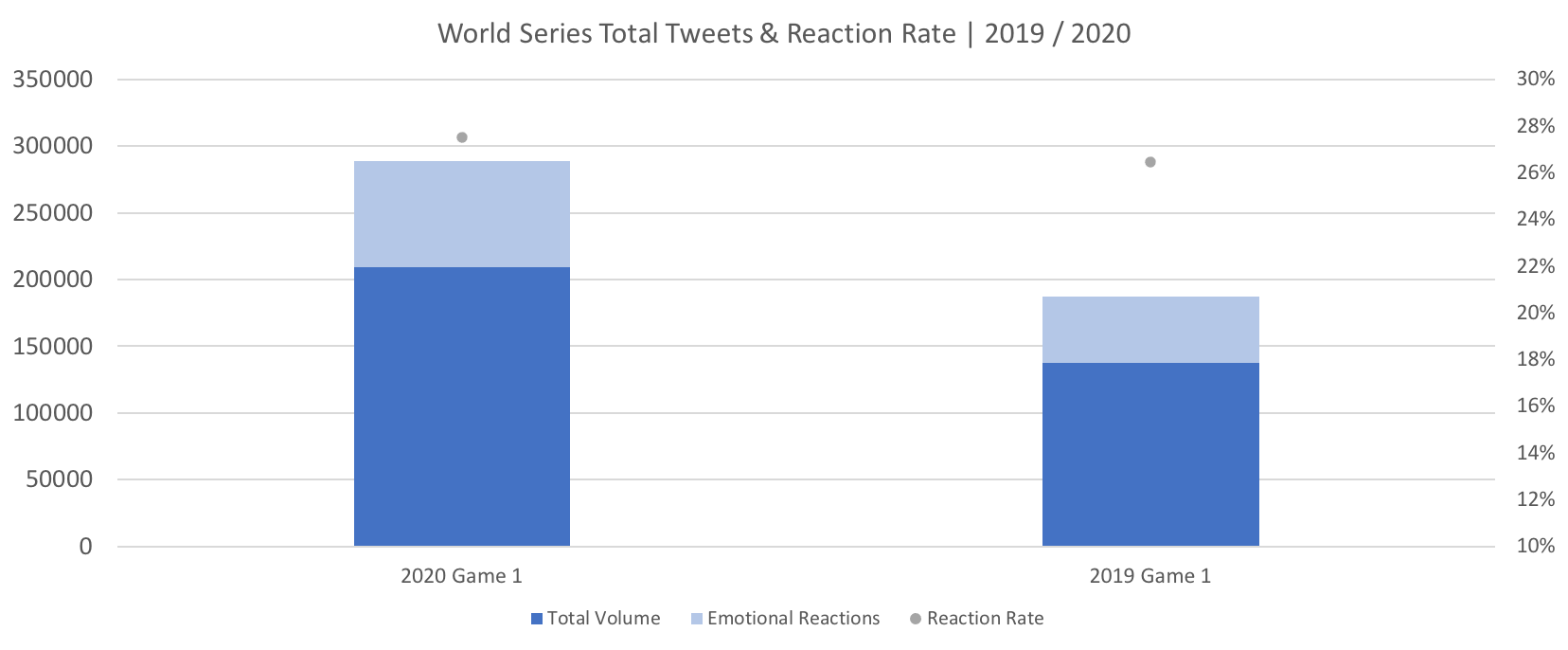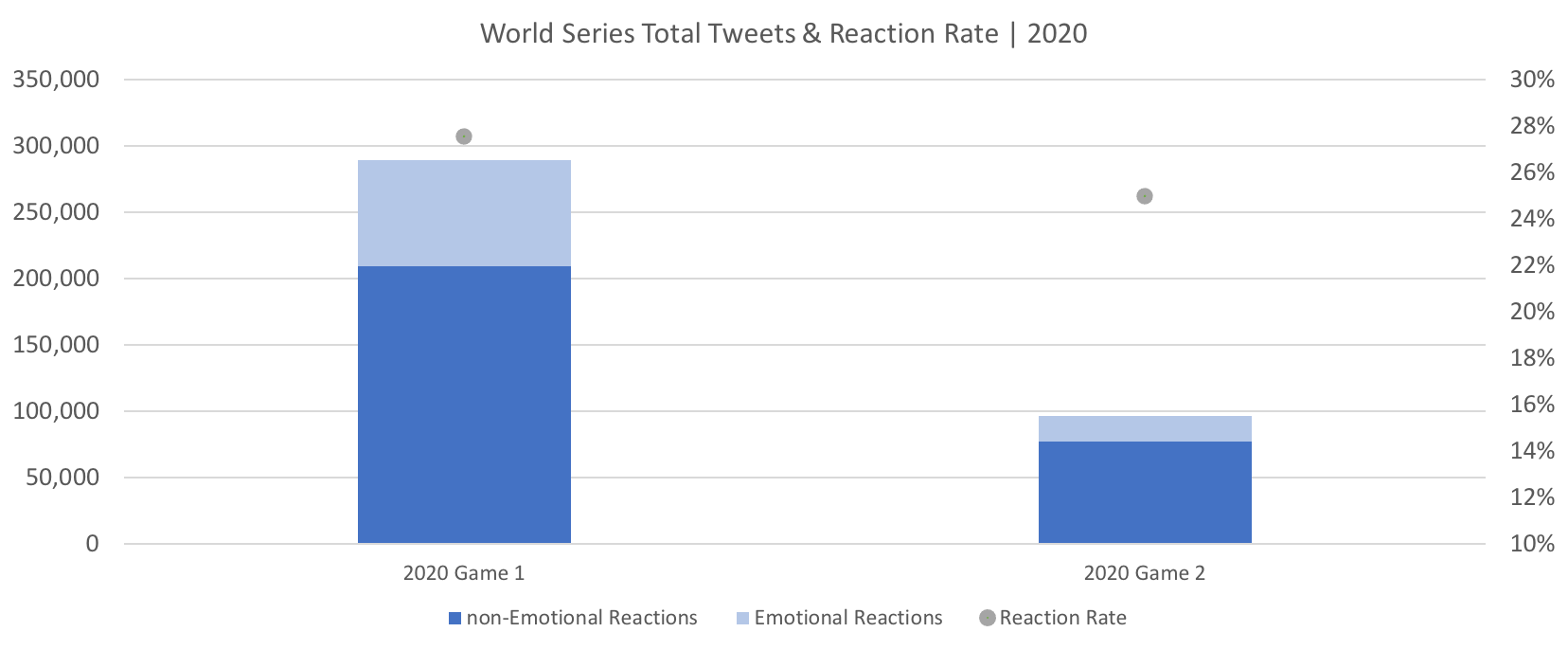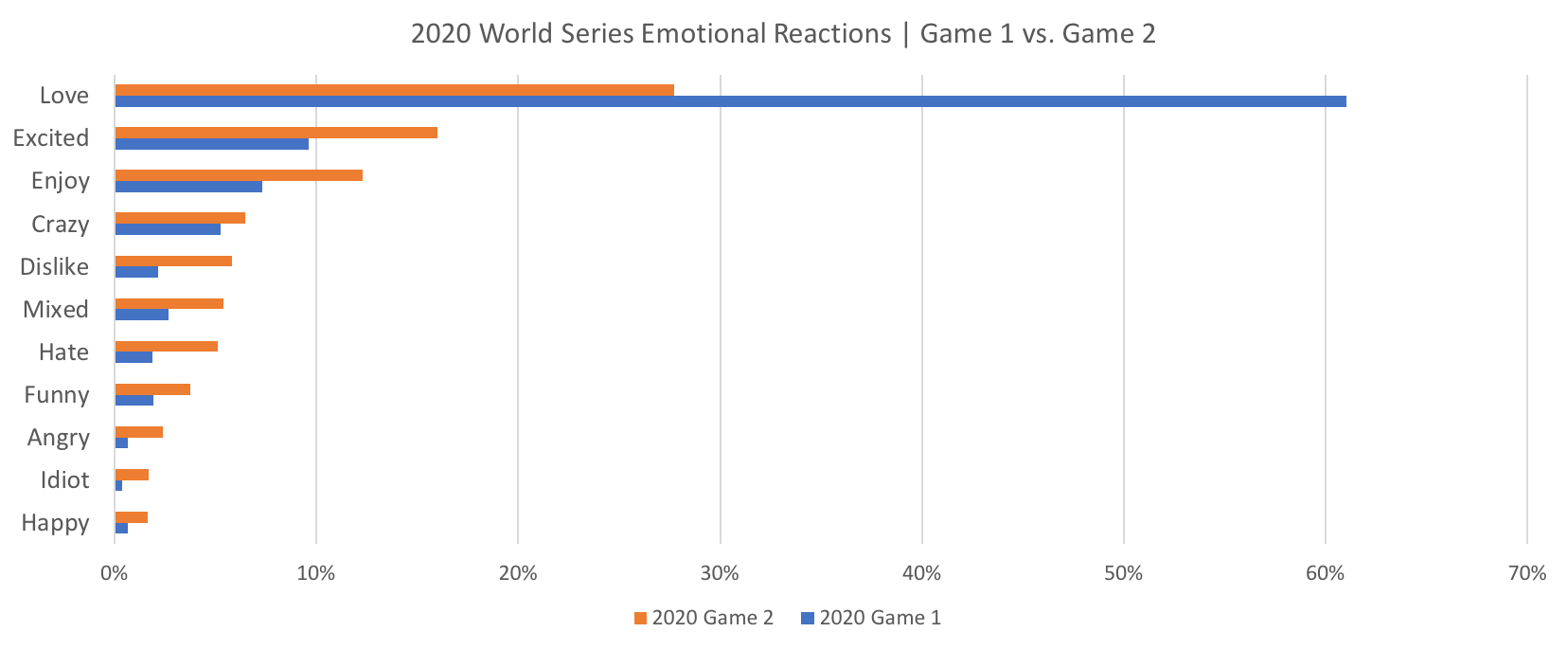The 2020 World Series: Game 1 Fan Reaction vs. Game 2
Earlier this week, the 2020 World Series kicked off between the Los Angeles Dodgers and the Tampa Bay Rays. Following a shortened season, MLB fans have enjoyed a modified playoff schedule this year bringing more teams into postseason action. We decided to take a look at how the 2020 World Series Opener compared to the 2019 World Series opener, which players have driven the most engagement this year, and why fans engaged less when the Tampa Bay Rays soundly won game two after being beat in game one.
The opening game of the World Series increased 61% in engagement year over year, with the Los Angeles Dodgers easily beating the Tampa Bay Rays
- Overwhelmingly, the 2020 World Series kicked off with massive levels of Emotional Engagement, with Emotional Reactions increasing from 50K in 2019’s World Series opener to 79K in 2020’s World Series opener, an increase of 61%
- Further, total Tweet volume also increased heavily in the first game of the 2020 World Series compared to 2019, from 187K in 2019’s World Series opener to 289K in 2020’s World Series opener, an increase of 54%
- Not only did we see a rise in both volume of Tweets and Emotional Reactions in the 2020 World Series opening game, the Reaction Rate on social media rose 2% year over year, from 26% in 2019 to 28% in 2020

- Beyond this year’s World Series opening game driving higher levels of Tweets and Emotional Reactions, it also was able to earn an extremely high 61% rate of ‘love’ Emotional Reactions, a 27% increase year over year and a clear shift towards higher rates of positive Emotional Reactions
- These high rates of ‘love’ Emotional Reactions were generally driven by fans showing support for the Dodgers who handily won Tuesday night’s game, and whose team drove 25% of all Emotional Reactions throughout the opener
- Mookie Betts (10% of all Emotional Reactions), Cody Bellinger (5% of all Emotional Reactions), and Clayton Kershaw (4% of all Emotional Reactions) were also successful in driving the three highest levels of Emotional Reactions among players
- Love Verbatims:
- “DODGERS BOUT TO BANKRUPT TACO BELL!! Mookie on 🔥🔥🏃🏽♂”
- “@Dodgers ARE OPENING THE FLOODS!!!! ⚾️🔥 #WorldSeries”
- “THAT’S FORMER OREGON DUCK GREAT CODY BELLINGER #Dodgers”
- These high rates of ‘love’ Emotional Reactions were generally driven by fans showing support for the Dodgers who handily won Tuesday night’s game, and whose team drove 25% of all Emotional Reactions throughout the opener
While the Dodgers were handled relatively easily in game 2, Emotional Reactions shifted heavily against the Dodgers and towards the Rays
- The story was different in the second game of the World Series Wednesday night, with the Tampa Bay Rays handily beating the Los Angeles Dodgers
- Emotional Reactions and total Tweets fell 73% and 76% respectively from game 1 to game 2, with the more engaged Dodger fans showing frustration with their team’s performance
- Further, there was a clear shift in Reaction Rate game over game, with fans emotionally engaging in the second game 2% less than in the first
- This dropoff is likely caused by the Dodgers poor performance and the more engaged fan base feeling less inclined to post

- One of the most notable shifts in behavior from games 1 & 2 is the frustration growing amongst Dodgers fans
- ‘Love’ Emotional Reactions decreased 33% in game 2, and ‘dislike’ and ‘hate’ Emotional Reactions increased 4% and 3% respectively
- Verbatims:
- Dislike: “As much as carrot top messed up, this blame goes on the Dodger bats.”
- Dislike: “Joe Kelly sucks now the Dodgers know we can't trust him in the postseason”
- Hate: “@Dodgers For God sakes! Gonsolin is trash. Can’t even stay an inning”
- Hate: “No wonder Tichenor is working his first World Series, it should be his last. He is garbage.”
- Verbatims:
- ‘Love’ Emotional Reactions decreased 33% in game 2, and ‘dislike’ and ‘hate’ Emotional Reactions increased 4% and 3% respectively
- While overall engagement fell, the Tampa Bay Rays were able to drive 8% more Emotional Reactions compared to game 1, and many of their star players were able to have a larger impact on engagements as well
- Blake Snell, pitcher for the Tampa Bay Rays, drove the highest amount of Emotional Reactions in game 2, accounting for over 5% of all engagement
- Mookie Betts, who was the largest driver of Emotional Reactions among players in game 1, drove only 4% of engagement in game 2, a 6% drop game over game

Takeaways
- The 2020 World Series opening game was able to drive extremely high levels of Emotional Reactions compared to last year due to the strong performance of the Los Angeles Dodgers
- Overwhelming, both the Dodgers organization and the stars of the team were the highest drivers of Emotional Reactions in the first game
- While Emotional Reactions and total Tweets fell heavily in game 2, Dodgers fans expressed frustration with the game while some of Tampa Bays stars were able to drive higher rates of engagement
Canvs, the leading emotion measurement technology company, connects consumer input to research insights with patented semantic AI technology to help companies deeply understand and empathize with their audiences
Interested in learning more about what fans think of your shows, advertisements or brand campaigns? Get in touch with us today!

